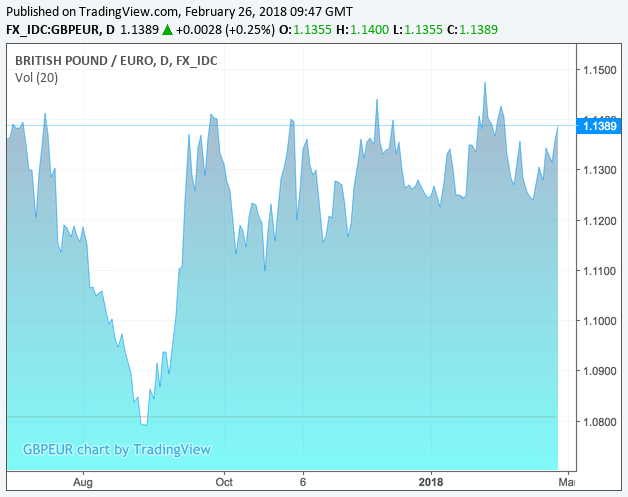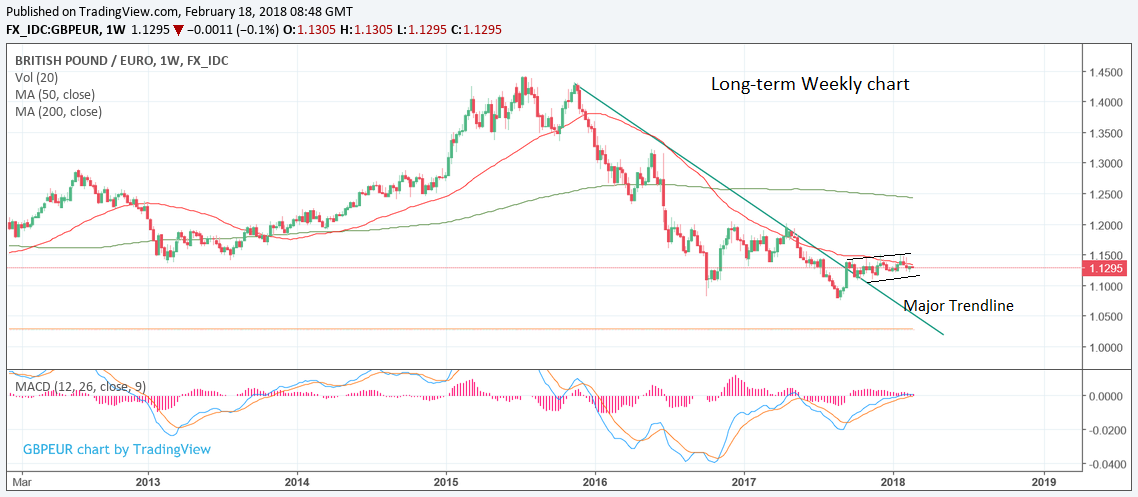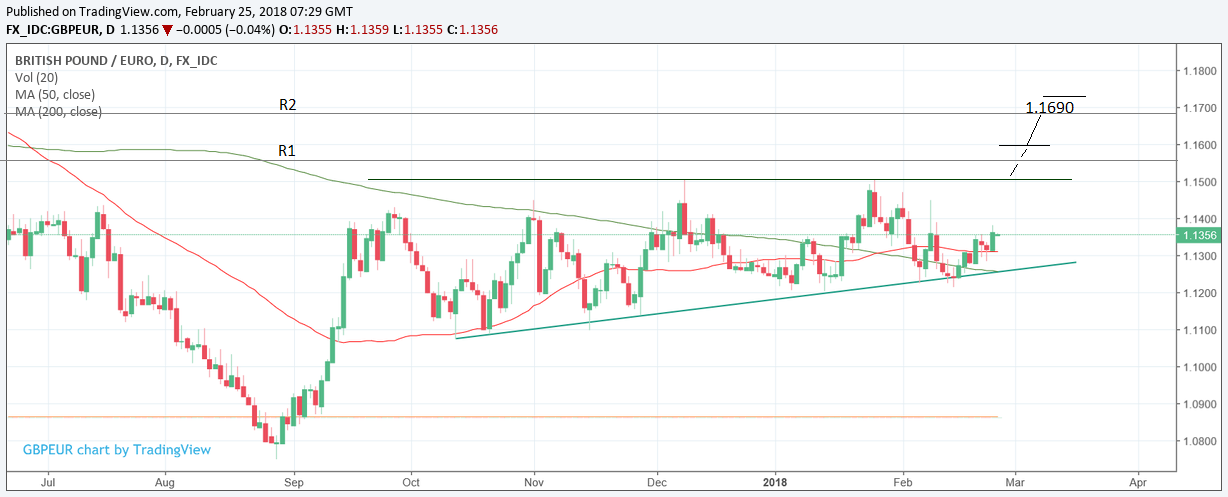Techs: Pound-to-Euro Rate Forecast for the Week Ahead

© Andrey Popov, Adobe Stock
The GBP/EUR exchange rate should extend its sideways trend for another week, but directional risks remain tilted to the upside.
Our technical studies of Pound Sterling suggest it is likely to be a case of 'more of the same' against the Euro as the exchange rate enters its sixth month of sideways trading.
Currently quoted at 1.1348, the pair is plum in the middle of a range bound by a ceiling at 1.1500 and a floor at 1.1200 and the trend is clearly sideways for now.
Our technical studies do however maintain there is an overall upside bias both from a technical and fundamental standpoint, which favours an eventual breakout higher.
Why do we think the pair will eventually breakout higher?

Looking at the above we can see the longer-term trend - in place over the last six months - has been one of appreaciation, even if it has been slow.
Our studies also confirm the pair has broken above a major trendline drawn from the 2015 highs (see below) and this is a long-term bullish sign.
Further, the look-and-feel of the chart also suggests the pair will probably go higher rather than lower.
From a fundamental perspective, which we discuss in further detail below, Brexit risks also appear to be dissipating and whilst this could be just the latest in a long list of false dawns the week ahead looks set to kick off with the Pound on strong footing after positive reports from the cabinet's consensus-building exercise at the Prime Minister's country residence Chequers.
Returning to the charts, however, and we would look for confirmation of an upside breakout from a move above the 1.1513 range highs.
A clearance above the R1 monthly pivot at 1.1560 would provide further confidence of a bullish extension higher.
The R1 is likely to present a significant obstacle to further upside, and although we expect it to be broken eventually those seeking confirmation should wait for a move above 1.1600 for bullish confirmation and a high probability of the exchange rate meeting the target at 1.1690, which itself is just below the R2 monthly pivot at 1.1693.
Pivots are calculated from the previous month's price data and are levels where prices often stall, pull-back or even reverse.
Pivots present traders with an opportunity to sell (in the case of an uptrend) in anticipation of a pull-back, which adds to the supply at that level, further enhancing the bearish pressure.
Get up to 5% more foreign exchange by using a specialist provider to get closer to the real market rate and avoid the gaping spreads charged by your bank when providing currency. Learn more here.
Data and Events to Watch for the Pound
From a fundamental perspective, the most important factor for the Pound in the coming week is the outcome of the extended cabinet meeting held at the Prime Minister's residence at Chequers to heal divisions and decide on a consensus approach to Brexit.
The outcome of the meeting will be crystalised in a speech due to be delivered by Prime Minister Theresa May on Friday, the location and exact time of the speech are yet to be made clear.
The British Pound was seen as one of the better performing global currencies towards the end of the previous week with markets cheering the UK government making progress on their Brexit strategy.
The promise of Conservative party unity on the issue of Brexit is a rare commodity, but this could well be on offer following Theresa May's decision to lock her top team in a room in the English country side and let them out only once agreement had been sought. Members of Cabinet emerged from the meeting with those on either side of the Brexit divide saying talks were constructive and a unified position had been found.
"GBP is top of the pack by a small margin, as reports suggest the cabinet is closer to agreeing a unified line on the UK’s post-Brexit relationship with the EU after the Chequers meeting ended late last night," says Adam Cole, Chief Currency Strategist with RBC Capital Markets.
Brexit remains the key story for Sterling and therefore the details of May's speech, and any European response, could therefore be key.
The issue of UK interest rates will be in focus with the Bank of England's Sir John Cunliffe delivering a speech on Monday at 18.00 GMT, in which he may drop hints as to the BoE's stance on monetary policy.
There is now a heightened expectation that the BoE will raise interest rates by 0.25% in May after statements made in the February meeting statement and more recently in front of the Treasury Select Committee indicated BoE members had adopted a more 'hawkish' stance - 'hawkish' meaning members are in favour of raising interest rates at a quickened pace.
If Cunliffe's speech further reinforces a more aggressively hawkish tightening strategy from the bank and a greater chance of a May hike, the Pound will rise, since higher interest rates are supportive of Sterling, because they attract greater inflows of foreign capital drawn by the promise of higher returns.
It is not expected to, however - Cunliffe dissented from raising rates in November and may well still be on the dovish spectrum.
Clearly, if he has become more hawkish it will be a strong indication of voting intentions and push the Pound higher.
"BoE’s Jon Cunliffe is set to speak on Monday following fellow Deputy Governor Dave Ramsden’s scheduled remarks tomorrow. Given that both dissented against the November rate hike, it will be interesting to see whether they maintain their reservations in the face of the hawkish testimony delivered to the Treasury Select Committee by the Governor Mark Carney and other MPC members," said Investec analysts George Brown and Victoria Clarke.
House price data from Nationwide is out on Thursday at 7.00 GMT and is expected to rise 2.6% in February compared to a year ago and 0.2% from the previous month. Housing leads the economy they say so it is important, but there are not expected to be any surprises in the Nationwide data, so little probable impact on Sterling.
The major economic release of the week is Thursday's release of Manufacturing PMI for February at 9.30 GMT, which is forecast to show a slowdown to 55.0 from 55.3.
PMIs are surveys of key personnel (Purchasing Managers) in a sector and provide a good leading indicator of growth and activity. A result of over 50 indicates expansion and below 50 - contraction.
Construction PMI is out on Friday at the same time and is forecast to come out at 50.7 in February from 50.2 previously.
Data and Events to Watch for the Euro
It's a big week ahead for politics in the European Union starting with the German CDU party's vote on whether or not form a grand coalition on Monday. This is Merkel's party so it is quite important they back a deal. If they vote against it is expected to send the Euro lower.
Then on Sunday the 4th of March it is the turn of the SPD to vote on the same question. Also on the 4th Italians will go to the polls to vote in their general election. No outright winner is expected at the moment but if 5-star start to forge ahead in the run-up to the vote the Euro may take some flack, however, it is unlikely they will receive enough votes to push for an Italexit and threaten the unity of the Euro-area.
Eurozone inflation data for February is out on Wednesday at 10.00 GMT and is expected to slow slightly to 1.2% from 1.3% a year ago.
Core CPI out at the same time is expected to come out at 1.0% - the same as a year ago.
Higher inflation tends to push up interest rates which tend to push up the Euro because higher interest rates expectations increase inbound foreign capital flows drawn by the promise of higher returns.
Therefore the inflation data on Wednesday may well be key for the Euro.
Another major release for the Euro in the week ahead will be January employment data which is forecast to come out at 8.6% from 8.7% in December. A fall in unemployment is positive for the single currency as it increases inflation pressures.
Get up to 5% more foreign exchange by using a specialist provider to get closer to the real market rate and avoid the gaping spreads charged by your bank when providing currency. Learn more here.






